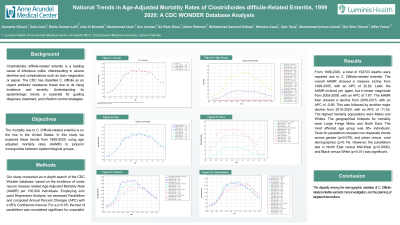Tuesday Poster Session
Category: Infections and Microbiome
P5563 - National Trends in Age-Adjusted Mortality Rates of Clostridioides difficile-Related Enteritis, 1999–2020: A CDC WONDER Database Analysis
Tuesday, October 28, 2025
10:30 AM - 4:00 PM PDT
Location: Exhibit Hall

Has Audio

Aanusha Ghouri, MD
Luminis Health Anne Arundel Medical Center
Annapolis, MD
Presenting Author(s)
Aanusha Ghouri, MD1, Saim Amir, MBBS2, Gul Sher Ghouri, MBBS2, Zain Tariq, MBBS3, Affan Faisal, MBBS2, Salal Sharjeel, MBBS4
1Luminis Health Anne Arundel Medical Center, Upper Marlboro, MD; 2King Edward Medical University, Lahore, Punjab, Pakistan; 3King Edward Medical University, Imperial, CA; 4Dow University of Health Sciences, Karachi, Sindh, Pakistan
Introduction: Clostridioides difficile-related enteritis is a leading cause of infectious colitis, often resulting in severe diarrhea and complications such as toxic megacolon or sepsis. The CDC has classified C. difficile as an urgent antibiotic resistance threat due to its rising incidence and severity. Understanding its epidemiologic trends is essential for guiding diagnosis, treatment, and infection control strategies.
The mortality due to C. Difficile-related enteritis is on the rise in the United States. In this study we explored these trends from 1999-2020, using age adjusted mortality rates (AAMR) to pinpoint incongruities between epidemiological groups.
Methods: Our study conducted an in-depth search of the CDC Wonder database, based on the incidence of Clostridioides difficile-Related Enteritis related Age-Adjusted Mortality Rate (AAMR) per 100,000 individuals. Employing Join point Regression Analysis, we assessed Parallelism and computed Annual Percent Changes (APC) with a 95% Confidence Interval. For a p< 0.05, the test of parallelism was considered significant for unparallel.
Results: From 1999-2020, a total of 192723 deaths were reported due to C. Difficile-related enteritis. The overall AAMR showed a massive incline from 1999-2005, with an APC of 32.62. Later, the AAMR inclined yet again, but in lesser magnitude from 2005-2008, with an APC of 7.87. The AAMR then showed a decline from 2008-2015, with an APC of -0.85. This was followed by another major decline from 2015-2020, with an APC of -11.52. The highest mortality populations were Males and Whites. The geographical hotspots for mortality were Large FringeMetro and North East. The most affected age group was 85+ individuals. Tests for parallelism revealed non-disparate trends across gender (p=0.079), and urban versus rural demographics (p=0.14). However, the parallelism test in North East versus Mid-West (p=0.0009), and Black versus White (p=0.01) was significant. The disparity among the demographic variables of C. Difficile-related enteritis warrants more investigation, and the planning of targeted interventions.
Discussion: The changing trends in C. difficile-related mortality likely reflect improvements in infection control and treatment practices over time. However, the marked differences between regions and racial groups point to ongoing gaps in healthcare access and delivery. These disparities highlight the need for more focused public health efforts and deeper investigation into the factors behind them.
Disclosures:
Aanusha Ghouri, MD1, Saim Amir, MBBS2, Gul Sher Ghouri, MBBS2, Zain Tariq, MBBS3, Affan Faisal, MBBS2, Salal Sharjeel, MBBS4. P5563 - National Trends in Age-Adjusted Mortality Rates of <i>Clostridioides Difficile</i>-Related Enteritis, 1999–2020: A CDC WONDER Database Analysis, ACG 2025 Annual Scientific Meeting Abstracts. Phoenix, AZ: American College of Gastroenterology.
1Luminis Health Anne Arundel Medical Center, Upper Marlboro, MD; 2King Edward Medical University, Lahore, Punjab, Pakistan; 3King Edward Medical University, Imperial, CA; 4Dow University of Health Sciences, Karachi, Sindh, Pakistan
Introduction: Clostridioides difficile-related enteritis is a leading cause of infectious colitis, often resulting in severe diarrhea and complications such as toxic megacolon or sepsis. The CDC has classified C. difficile as an urgent antibiotic resistance threat due to its rising incidence and severity. Understanding its epidemiologic trends is essential for guiding diagnosis, treatment, and infection control strategies.
The mortality due to C. Difficile-related enteritis is on the rise in the United States. In this study we explored these trends from 1999-2020, using age adjusted mortality rates (AAMR) to pinpoint incongruities between epidemiological groups.
Methods: Our study conducted an in-depth search of the CDC Wonder database, based on the incidence of Clostridioides difficile-Related Enteritis related Age-Adjusted Mortality Rate (AAMR) per 100,000 individuals. Employing Join point Regression Analysis, we assessed Parallelism and computed Annual Percent Changes (APC) with a 95% Confidence Interval. For a p< 0.05, the test of parallelism was considered significant for unparallel.
Results: From 1999-2020, a total of 192723 deaths were reported due to C. Difficile-related enteritis. The overall AAMR showed a massive incline from 1999-2005, with an APC of 32.62. Later, the AAMR inclined yet again, but in lesser magnitude from 2005-2008, with an APC of 7.87. The AAMR then showed a decline from 2008-2015, with an APC of -0.85. This was followed by another major decline from 2015-2020, with an APC of -11.52. The highest mortality populations were Males and Whites. The geographical hotspots for mortality were Large FringeMetro and North East. The most affected age group was 85+ individuals. Tests for parallelism revealed non-disparate trends across gender (p=0.079), and urban versus rural demographics (p=0.14). However, the parallelism test in North East versus Mid-West (p=0.0009), and Black versus White (p=0.01) was significant. The disparity among the demographic variables of C. Difficile-related enteritis warrants more investigation, and the planning of targeted interventions.
Discussion: The changing trends in C. difficile-related mortality likely reflect improvements in infection control and treatment practices over time. However, the marked differences between regions and racial groups point to ongoing gaps in healthcare access and delivery. These disparities highlight the need for more focused public health efforts and deeper investigation into the factors behind them.
Disclosures:
Aanusha Ghouri indicated no relevant financial relationships.
Saim Amir indicated no relevant financial relationships.
Gul Sher Ghouri indicated no relevant financial relationships.
Zain Tariq indicated no relevant financial relationships.
Affan Faisal indicated no relevant financial relationships.
Salal Sharjeel indicated no relevant financial relationships.
Aanusha Ghouri, MD1, Saim Amir, MBBS2, Gul Sher Ghouri, MBBS2, Zain Tariq, MBBS3, Affan Faisal, MBBS2, Salal Sharjeel, MBBS4. P5563 - National Trends in Age-Adjusted Mortality Rates of <i>Clostridioides Difficile</i>-Related Enteritis, 1999–2020: A CDC WONDER Database Analysis, ACG 2025 Annual Scientific Meeting Abstracts. Phoenix, AZ: American College of Gastroenterology.
